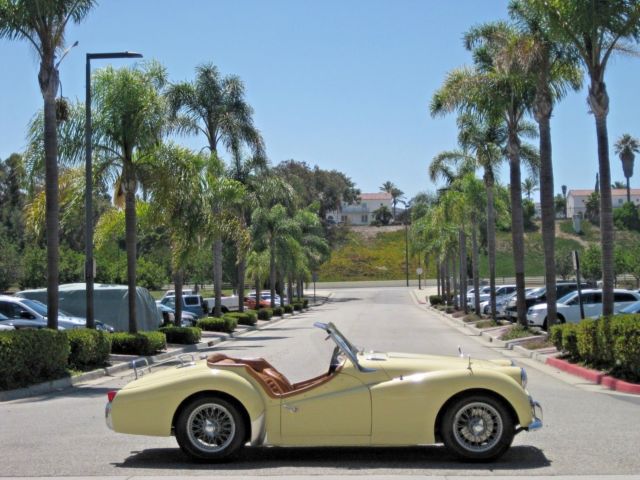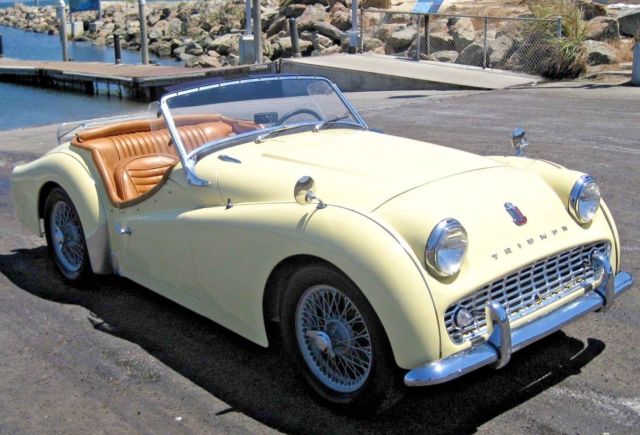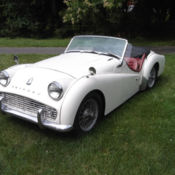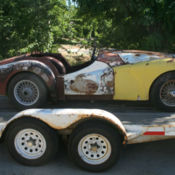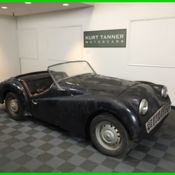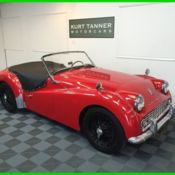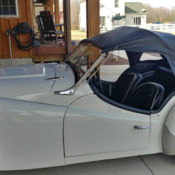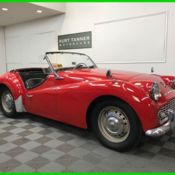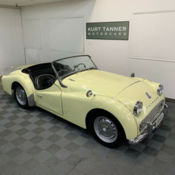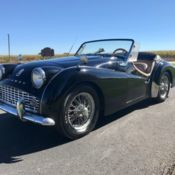1958 Triumph TR3A
1958 Triumph TR3A
Prior to me, this car had been owned by the same owner since 1983. It is an older restoration and has continued as a "Rolling Restoration" where things that needed replaced were replaced and work required to keep it running was done.- The interior was redone proffessionally and looks great. Correct white piping and a nice set of carpets. New seat belts were added.
- It has the rear seat option and the front seats have no slides as the previous owner set them back and never needed to move them.
- Dash is very nice, all guages were rebuilt and the temp guage is nos.
- New $550.00 gas tank, fitting kit, sending unit, gas cap and filler hose.
- New radials and wheels have just been painted, new knockoff!!
- New front end bits,brakes and more.
- Previous owner said motor was rebuilt around 12 years ago.
- New knockoffs on repainted wire wheels
- New battery and amco battery box
- New distributor and full tune up, idles perfect and has great acceleration
- Carbs completely rebuilt and new correct air filters
I'm sure more new stuff....I just can't think of it !
Although the car was usually supplied as an open two-seater, an occasional rear seat and bolt-on steel hard top were available as extras.
The car is powered by a 1991ccstraight-fourOHVengine initially producing 95bhp (71kW; 96PS), an increase of 5hp over the TR2 thanks to the largerSU-H6 carburettors fitted. This was later increased to 100bhpat 5000rpm[5]by the addition of a "high port" cylinder head and enlarged manifold. The four-speedmanual gearboxcould be supplemented by an overdrive unit on the top three ratios, electrically operated and controlled by a switch on the dashboard. In 1956 the front brakes were changed from drums to discs, the TR3 thus becoming the first British series production car to be so fitted.[8]
The suspension is by doubleA-arms,manganesebronzetrunnion, coil springs and tube shocks at the front, optional anti-roll bar, and with worm and peg steering. UnlikeMGsof the same period, the steering mechanism and linkage have considerable play and friction, which increase with wear.
The rear is conventionalleaf springs, with solid axle and lever arm dampers, except that the (box) frame rails are slung under the axle. The wheels are 15 inches in diameter and 4.5 inches wide (increased from 4 inches after the first fewTR2s), with 48-spoke wire wheels optional. Wire wheels were usually painted, either body colour or argent (silver), but matt chrome and bright chrome were also available. The frontdiscordrumbrakes and rear drums have no servo assistance.
The TR3's weight is significantly more than theMorgan +4and thePorsche 356, but not much more than theMG-AandMG-B. All except the Morgan, which shares the same engine, are substantially less powerful as is theSunbeam Alpine.
Under most conditions the car is very responsive and forgiving, but it has somehandlingissues. The chassis, which is shared by the TR2, TR3, TR3A and TR4 has limited wheel travel. As a result, on very hard cornering, the inside rear wheel can lift, causing sudden over-steer due to the increased load on the outside rear tyre. This is particularly true with radial tyres; the original TR2/3/3A suspension was built with older, crossply tyre designs in mind. The wheel lifting is more sudden than that of other cars, because it is caused by coming to the end of the suspension travel while there is still load on the tyre, so the load on the other (outside) rear wheel is a discontinuous function of cornering load, rather than just changing slope.
The TR3 is a true roadster, designed for sunny weather but with removable rain protection. It has a convertible hood (UStop) that snaps on and off and removable side curtains, allowing very low doors with padding for the driver's arm to rest on. There are holes in the floor, with rubber plugs, so that the originally supplied jack might be used from inside the car, as did theJaguar XK120. The optional heater is poor and the shut-off valve is under the bonnet (UShood). A third person can be carried behind the seats.
Some 13,377[9]examples of the original "pre-facelift" TR3 were produced, of which 1,286 were sold within the UK; the rest were exported mainly to the USA. As of Q1 2011 there were approximately 826 licensed and 115SORNTR3/3as registered with theDVLA.[10]
TR3 specifics[edit]- Production period – October 1955 to Summer 1957
- Original price (basic model) – £950
- Suspension – Front: independent by unequal-length double wishbones, coil springs and telescopic dampers. Rear: live axle, half-elliptic springs, lever arm dampers.
- Brakes – First 4408 models (1955–56): 10in (254mm) drums all around. Remaining 9000 (1956–57): front discs; rear drums[11]
- Factory options and extras – Triumph offered a wide range of optional parts and accessories for both the competition-minded enthusiast and those simply wishing to personalize their vehicle. While many of these items were factory fitments, local dealers supplied some as well. Among these were: overdrive, wire wheels (48-spoke, 60-spoke available from 1959), steel hardtop kit (part No. 900711), occasional rear seat (No. 801264), push-button radio, interior heater, leather upholstery, windscreen washer (No. 553729), cast aluminium sump (No. 502126), 2138cc engine (from 1959), aluminum ‘Al-fin’ brake drums (No. 202267 or No. 301590 (9- and 10-inch respectively)), spot and fog lamps (Nos. 501703, 501702), and a continental touring kit (No. 502022, spares for travels in remote regions).[12]
A hardtop car with overdrive tested by the British magazineThe Motorin 1956 had a top speed of 105.3mph (169.5km/h) and could accelerate from 0–60mph (97km/h) in 10.8 seconds. A fuel consumption of 27.1 miles per imperial gallon (10.4L/100km; 22.6mpg-US) was recorded. The test car cost £1,103 including taxes.[5]
Other figures recorded included:
- Condition: Used
- Make: Triumph
- Model: TR3A
- Year: 1958
- Mileage: 14,500
- VIN: TS27056L
- Color: White
- Interior color: Black
- Vehicle Title: Clear Want to buy? Contact seller!
